
Shi Potian talks about purple sand: the variety of purple sand mud and its true and false
Share
Let me talk about the mineral properties of purple sand mud first. Some books and periodicals have made some more professional descriptions in the past. Zisha ore veins actually only exist in the hilly areas in the southern part of Yixing, Jiangsu Province, but few people have mentioned the actual situation of Zisha mud mines, the proportion of finished soil, and the naming of mud varieties. The introductions of those mineral veins, in fact, only a few organizations have done real survey and analysis and have first-hand information. The introductions that you have seen from this and that are all plagiarized and borrowed from each other, and some have been misrepresented or even embellished. , How can the market and players know the authenticity of these contents?

Regarding the ratio of clay, it should be regarded as a relatively professional topic. Generally, the insiders seem reluctant to say more, and more people may have no way to say, because more than 99% of potters buy finished clay for use, and do not involve this aspects of the subject. Most of the gentlemen who write related articles rarely practice it in person. For market players, if they want to know something, of course they have no choice but to read the ready-made introduction articles in the book and just join in the fun.

For example, the name "cleaning cement" makes the ears of those who play pots callous, but it is estimated that most people do not have a real understanding of what clearing cement is. The five purple sand factories more than ten years ago had their own mud workshops, which are responsible for the processing of various finished muds required by the factories. Generally speaking, there are more than five to eight varieties. The preparation of most varieties needs to be prepared by two or more different mineral materials in a certain proportion. For the ideal color effect, some metal oxides must be added to disperse and mix in, and each kind of mud must be mixed. Add 0.2-0.3 % barium carbonate fine powder to convert the free sulfate which is harmful to billet making. Only the natural color purple mud made from the same mud ore without adding any chemical materials is called "clear cement". It stands to reason that this kind of clear cement belongs to the real natural pure mineral mud material. However, because its color is light and yellowish, it is far less good-looking than the ones with added pigments. Therefore, only a few people still use clear cement to make pots, and only a few people Love the real clear cement works. However, many teapots on the market that are said to be made of clear cement are actually selling concepts.
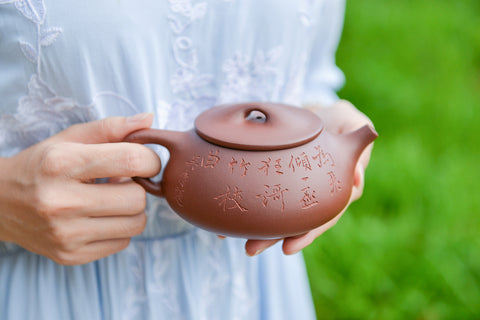
As for the question of adding "chemicals"
First. Adding metal pigments to purple sand mud is not a matter of recent decades. The ancestors may have used chemical pigments such as iron oxide and cobalt oxide after the middle of the Qing Dynasty. According to some special colors discovered in the early 1980s If you look at the old teapot, you can infer the facts of its history. Since the Republic of China, the use of colorants has become more common. In the past, the Zisha factory called it the "Purple" mud that I was used to, but it is actually a purple mud blended with oxidized pigments. As for some dealers who can't explain clearly to customers, they give some spiritual comfort to those "single-minded" buyers, and they may not necessarily be sincerely willing to deceive themselves.

Nowadays, most of the materials used in purple clay teapots on the market have more or less added such and such metal oxides! Why are the vegetables and fruits on the market sold with pesticides and fertilizers? Restaurants that don't use MSG may be closed! That's because human nature has weaknesses and misunderstandings in thinking, and lies are sometimes the cheapest and most effective placebo.

second. There are indeed some inorganic pigments with active chemical properties that cannot be used in purple sand pottery clay, such as copper oxide and lead oxide. The reason is that these oxidized metals are "soft" in nature, and free ions are easily precipitated in water, not to mention that there are many acid-base substances in tea water? The fact is that there may be teapots made of mud with those active oxides added on the market, but they are still a minority. As for those "watching pots", although some unusable things are added for a certain color effect, basically no one uses them to make tea, so there is no need to worry too much.

third. In order to pursue the color effect, after adding some necessary and stable oxidized pigments to the mud, the crystallinity of the teapot made must be fully burned, otherwise, some of the remaining pigments in the process of preparing the pigments will not be completely burnt. The metal ions in the reaction may still be combined with the tea containing tannic acid and some alkaloids in the boiling water to be drunk into the human body, which is undoubtedly harmful to the human body.

The problem is that some teapots that require color expression are often not allowed to burn to a sufficient temperature, otherwise the color will not be preserved. Therefore, as long as you don't choose colorful or half-baked teapots for use, you don't need to think about and worry about whether the purple sand teapot is poisonous or not.

In addition, although the barium carbonate (mildew remover) added in the preparation of the mud is a small amount, if the temperature is not sufficient for sintering, the result will be more serious if free barium is produced under the action of tea. Therefore, the degree of sintering of the pot body is the most critical.
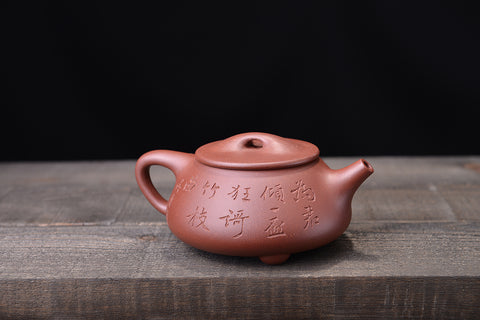
In fact, only a purple sand teapot that has been fully heated can be regarded as a good teapot. Although some iron defects will appear after burning through, this is inevitable for natural good mineral sources, and the effect of using a fully burnt teapot will also be special. good. Tycoon pots from the Qing Dynasty are really good! His pots are very particular about every aspect, and the fire is very thorough, and most of them are a little "overcooked", which happens to be a major feature of Daheng's pots! It shouldn't be unreasonable...
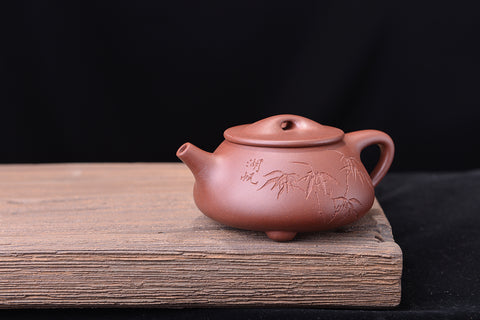
Let’s talk about the conventional composition of purple sand mud and the names of mineral varieties:
Several kinds of mud prepared according to traditional requirements are: purple mud, red mud, satin mud, dark green mud and black mud, etc., which are the so-called five-color soil. The earliest and most authentic mineral deposits are all derived from the middle of the interlayer under Benshan (Dingshan's local Huanglong Mountain), and exist in the form of multi-interlayer blocks.

Huanglong Mountain is a small Huangshi mountain. Due to the mining of ore for construction, Huangshi has been consecrated and there is no hillside (the Qinglong Mountain adjacent to the west has also been blasted flat due to the mining of bluestone). The purple sand mud deposits hidden at the bottom of Huanglong Mountain are relatively deep. Most of them need to dig tunnels to build deep wells, and then dig down layer by layer. The mining situation of No. 4 well is as follows from top to bottom: fake soil (messy waste) → mixed mud (purple-brown hard and miscellaneous ore lumps) → purple mud (purple purple-red, which is stipulated to be used to mix purple sand mud) part)→green mud (the so-called Benshan green mud) or black mud (the hardest jet-black mud), but the stratification of some sections is not very clear and orderly, which leads to the mud in different periods slidely different. When these muds are excavated, they are all pulled out of the wellhead by rail trolleys and motors for sorting and sorting. The colors, textures and properties of various lumps of mud are not exactly the same, and their whereabouts and uses are also different.

Before the 1990s, Yixing Ceramics Company had more than 20 affiliated manufacturers. The mining of all ceramic minerals near Dingshu Town is carried out by the raw material general factory under the company, and then distributed according to the production needs of each factory. More than 90% of the soil produced by the raw material factory is supplied to units other than the purple sand factory. Except that most of the purple clay and green clay produced from Huanglongshan Mine, as well as three or four kinds of materials mixed with red clay from other places are sent to Zisha Factory, all other mineral materials are supplied to ceramic companies for about twenty years. For a pottery manufacturer, the demand of these units is dozens or even hundreds of times that of the purple sand factory. Therefore, mud is the main material for making a large number of coarse pottery. At the beginning, it was not used to make teapots at all, and at most it was only used as flower pots. ). Of course, it’s not that teapots cannot be made with clay, it’s just harder, darker and less crystalline than purple clay. Once purple clay is strained, it will inevitably become the main raw material for purple sand products. The "Jia Ni" mentioned in many books is actually the result of miswriting, misrepresenting, and miscopying the "Jia" Ni. It is said to be released because of its "body like iron armor", but in terms of color and hardness, the black mud is more like "iron armor"...

This problem was once mentioned by an expert in one of his books. But more people have always been copying what others say, copying and copying. However, in order to respond to some guests' questions, he is often forced to read and endorse books, regardless of whether he is right or wrong, and copy the original text. Yes, some people believe it. It seems that he has become more perfect in this way... In fact, to really know Zisha clay, it is impossible to understand it just by reading books and listening to stories. There are four or five authentic Zisha clay mining sites near Yixing. There are more than a dozen mud mines that can be used as substitutes for making teapots. If you don’t work hard to investigate and collect them one by one; if you don’t research and test the various raw muds you collect, how can you get these substantial muds? What about first-hand professional information? Therefore, most of the many rumors about Zisha mud are not true, but "tools" and "magic weapons" fabricated for the purpose of promoting products.
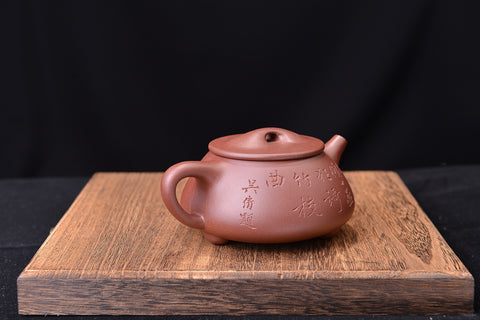
Purple sand clay is a general term for five-color soil. There are several varieties of purple clay, which need to be distinguished according to their viscosity, purity, hardness, and fineness.
The "bottom groove green" that is hotly fried now does not seem to have this name before. According to this texture, it was not the best purple clay more than ten years ago. The nature of slot green is harder and more complex, far less pure. In the past, good purple mud was made by blending mineral materials such as tender purple mud and bottom groove green. Such mud is superior in terms of viscosity, grade ratio, plasticity and texture level. With the continuous expansion of market demand, it is becoming more and more difficult to pay attention to, not to mention that kind of good tender purple mud is no longer seen. In this way, bottom groove green has become one of the best varieties.
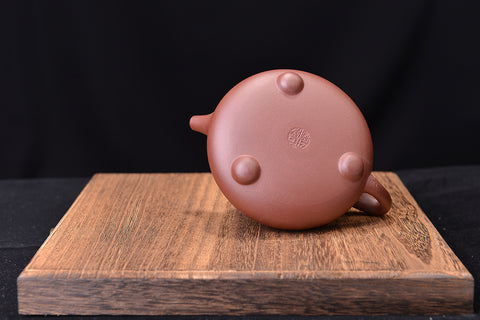
Of course, no matter what kind of purple mud ore is used, it can be used alone as a finished mud. In recent years, some new types of mud such as "Red Skin Dragon" and "Jiangpo Mud" were discarded or mixed with shallow clay for rough pottery in the past. With the continuous expansion of the purple sand market, these miscellaneous muds have also become the top grade of high-grade raw ore.
